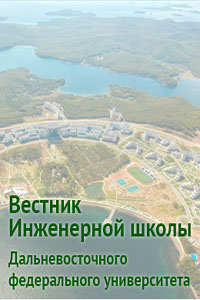Strength and effectiveness of external ice reinforcements in areas with a longitudinal scantling system
DOI:
https://doi.org/10.24866/2227-6858/2025-2/26-37Keywords:
ship’s hull, external ice reinforcements, strength, efficiencyAbstract
The practice of shipbuilding makes extensive use of external reinforcements of ship hulls, for example in the form of rubbing strake for mooring or in the form of bar keels for contact with the ground, as well as in other cases. In recent years, external ice reinforcement of hulls in the waterline area has become increas-ingly widespread in the world and in domestic practice. They are quite effective as a wear protection and increase the strength of the shell plaiting against the forces of ice. Such reinforcements are of relevance for foreign-built vessels operating in Russian conditions. The greatest damage is typical in the areas of the bulb stem and in areas with a longitudinal scantling system. The practice of implementing external ice reinforcements includes a wide range of constructive solutions that are not regulated in the regulatory documents of classification societies and are not sufficiently reflected in the scientific and technical literature. The paper considers a wide range of issues related to the analysis of the strength and effectiveness of external ice reinforcements for hull areas with a longitudinal scantling system. Comparisons of solution options are made and directions for further research are shown.
References
1. Попов Ю.Н., Фадеев О.В., Хейсин Д.Е., Яковлев А.А. Прочность судов, плавающих во льдах. Судостроение. Ленинград, 1967. 224 с.
2. Курдюмов В.А., Тряскин В.Н., Хейсин Д.Е. Определение ледовой нагрузки и оценка ледовой прочности корпусов транспортных судов // Труды ЛКИ, сборник «Ледопроходимость и ледовая прочность судов». Ленинград, 1979. С. 3–12.
3. Апполонов Е.М., Нестеров А.Б., Копилец Н.Ф., Дидковский А.В. О проекте новой редакции требований Правил РМРС к ледовой прочности судов и ледоколов // Судостроение. 1997. № 5. С. 10–20.
4. Апполонов Е.М., Нестеров А.Б., Тимофеев О.Я. Обеспечение ледовой прочности и безопасной эксплуатации судов в российских арктических и замерзающих морях на основе комплексной системы формирования принципиальных инженерных решений // Труды ЦНИИ Крылова. 2008. Вып. 39(323). С. 69–89.
5. Руководство по оценке напряжённо-деформированного состояния судовых корпусных конструкций на основе МКЭ. НД № 2–030101–045. РМРС. СПб., 2021. 11 с.
6. Правила классификации и постройки морских судов. Часть II. Корпус. РМРС. СПб., 2024.
7. Finite element analysis. Class guideline – DNVGL-CG-0127, 2015. 93 p.
8. Kulesh V.A., Kuteynikov M.A., Zhitnikov I.V. Solutions for ice strength of hulls of vessels in service // Proceedings of the 24th Asian-Pacific Technical Exchange and Advisory Meetings on Marine Structures. Vladivostok, 2010. P. 150–153.
9. Каленчук С.В., Кулеш В.А. Ледовая прочность корпусов морских судов. Этапы развития, проблемы и перспективы // Вестник ДВГТУ. 2010. № 3(5). С. 137–151.
10. Правила классификации и постройки морских судов. Часть XVII. РМРС, Дополнительные символы. СПб., 2023. 477 с.
11. Kulesh V.A. Improving operational reliability of ice reinforcements of vessels hulls // Asia-Pacific Journal of Marine Science & Education. 2013. Vol. 3, № 1. P. 9–14.
12. Кулеш В.А., Огай С.А., Пец Н.Г. Проект ледовых усилений сухогрузного судна // Морские интеллектуальные технологии. 2017. Т. 2, № 3(37). С. 64–70.
13. Кулеш В.А., Пец Н.Г., Приемкин А.В. Анализ опыта эксплуатации и эффективности наружных ледовых усилений корпуса // Научно-технический сборник РМРС. 2019. № 56/57. С. 84–93.
14. Кулеш В.А., Пец Н.Г. Эффективность наружных ледовых усилений с наклоном полос // Морские интеллектуальные технологии. 2020. Т. 2, № 1. С. 71–81.
15. Кузнецов Э.А., Кулеш В.А., Суров О.Э., Фам Ч.Х. Проблемы ледовой регламентации «не эталонных» конструкций // Морские интеллектуальные технологии. 2023. № 3, ч. 3. С. 23–29.
Downloads
Published
Issue
Section
License
Copyright (c) 2025 Far Eastern Federal University: School of Engineering Bulletin

This work is licensed under a Creative Commons Attribution 4.0 International License.

